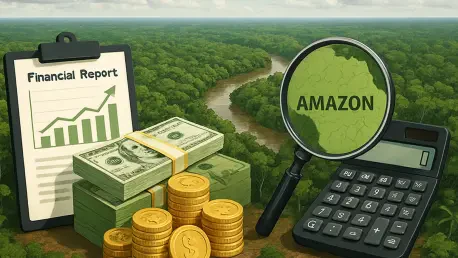In a striking move that underscores the growing intersection of finance and environmental stewardship, JPMorgan Chase, one of the world’s leading financial institutions, has unveiled a pivotal update to its sustainability policies targeting the Amazon biome. This vast region, often dubbed the lungs of the planet, now joins the Arctic as a focal point for intensified risk assessment in the bank’s operations. Revealed in their latest sustainability report, this policy shift responds to escalating concerns over industrial activities such as oil and gas extraction, which pose significant threats to the Amazon’s delicate ecosystems and the Indigenous communities that depend on them. As global attention sharpens on protecting critical natural zones, the bank’s decision marks a notable step toward aligning financial practices with environmental and social governance priorities, while still navigating the complex balance of commercial interests and ecological responsibility.
A Deeper Dive into Enhanced Oversight
JPMorgan Chase’s newly implemented policy introduces enhanced due diligence for clients conducting business within the Amazon biome, signaling a commitment to more rigorous evaluation of their activities and financial dealings. This approach does not equate to an outright prohibition on funding projects in the region but instead emphasizes a tailored, case-by-case analysis. Decisions will hinge on the bank’s risk tolerance and strategic business goals, reflecting a deliberate effort to address environmental challenges without completely withdrawing from potentially lucrative opportunities. This careful positioning highlights the intricate balance financial giants must strike between advancing sustainability and maintaining profitability in a world increasingly focused on corporate accountability.
Beyond the immediate policy framework, this enhanced scrutiny reveals a broader intent to mitigate reputational and operational risks tied to environmentally sensitive areas. While the bank aims to curb potential harm through detailed assessments, the absence of strict bans leaves room for flexibility in supporting certain projects. This has sparked discussions among stakeholders about whether such measures adequately protect the Amazon or merely serve as a surface-level response to mounting external pressures. The policy’s effectiveness will likely depend on how consistently and transparently these evaluations are applied to client engagements in the region.
Aligning with Local Perspectives on the Amazon
A standout feature of JPMorgan Chase’s updated approach is the adoption of the Amazon biome’s boundaries as defined by the Amazon Network of Georeferenced Socio-Environmental Information (RAISG), a standard widely supported by Indigenous leaders and activists. This decision reflects a meaningful acknowledgment of local and community-driven viewpoints, recognizing the Amazon as a sprawling, cross-border region vital to global biodiversity and climate stability. By aligning with RAISG’s framework, the bank signals an intent to incorporate perspectives that prioritize the region’s cultural and ecological significance over purely economic considerations, setting a precedent for how financial institutions might engage with sensitive areas.
However, the practical implications of this alignment remain under scrutiny, as defining the region is only the first step in ensuring its protection. Questions linger about how this framework will influence the bank’s decision-making process when evaluating projects that could impact the Amazon’s ecosystems or the livelihoods of Indigenous populations. While the adoption of RAISG’s boundaries is a positive gesture toward inclusivity, the true test lies in whether it translates into tangible outcomes, such as rejecting harmful initiatives or fostering sustainable development that respects local rights and environmental needs.
Facing the Heat from Critics and Shareholders
The backdrop to this policy update is a wave of criticism and shareholder activism directed at JPMorgan Chase for its historical role in financing oil and gas expansion in the Amazon, a trend documented as significant over recent years. Reports have positioned the bank as a leading funder of such activities, drawing ire from environmental advocates and intensifying calls for accountability. In 2024, a notable 30% of shareholders backed a proposal demanding greater transparency on the bank’s practices concerning Indigenous rights, underscoring the growing influence of investor voices in shaping corporate behavior on environmental and social fronts.
In response to these pressures, negotiations with stakeholders led to a commitment from JPMorgan Chase to disclose how it considers “free, prior, and informed consent” in transactions affecting Indigenous communities. This disclosure, prompted by sustained advocacy, represents a step toward addressing intertwined environmental and human rights concerns. Yet, skepticism persists among critics who argue that while these concessions mark progress, they do not fully resolve the underlying issues of funding destructive projects. The tension between shareholder expectations and corporate strategy continues to define the bank’s path forward in sensitive regions like the Amazon.
A Wider Lens on Risk Management
This focus on the Amazon biome is not an isolated measure but part of a comprehensive due diligence framework at JPMorgan Chase, which extends to other high-risk sectors such as coal mining, hydropower, and conflict minerals trading. By embedding the Amazon policy within a broader strategy, the bank demonstrates an overarching approach to managing environmental and social risks across its global operations. This holistic perspective aims to safeguard against the multifaceted challenges posed by industries with significant ecological footprints, positioning the institution as a player in the evolving landscape of sustainable finance.
Nevertheless, environmental groups, including the Rainforest Action Network, contend that these efforts represent only the bare minimum required to address the scale of the crisis facing fragile ecosystems. Critics argue that without firm commitments to exclude financing for harmful activities in the Amazon and similar regions, such policies risk being perceived as symbolic rather than transformative. The debate over whether incremental steps or outright bans are more effective in protecting vulnerable areas remains unresolved, with the bank’s framework serving as a litmus test for how far financial institutions are willing to go in prioritizing sustainability over short-term gains.
Industry Shifts and the Power of Advocacy
The financial sector is undergoing a profound transformation, with environmental, social, and governance (ESG) criteria becoming integral to operational strategies, a trend mirrored by JPMorgan Chase’s latest policy update. Banks and similar institutions face escalating scrutiny for their roles in funding projects linked to deforestation, climate change, and human rights issues, prompting a reevaluation of traditional practices. This shift is driven by a recognition that long-term viability hinges on mitigating risks associated with environmental degradation, a reality that has pushed sustainability to the forefront of corporate agendas across the industry.
Stakeholder activism, fueled by shareholders and organizations like Stand.earth, plays a crucial role in this evolution, amplifying demands for transparency and accountability. These groups have successfully influenced policies by advocating for the prioritization of ecosystem protection and community consent, as evidenced by the bank’s recent commitments. However, opinions remain divided on the sufficiency of enhanced due diligence, with ongoing debates about whether such measures truly safeguard critical regions or merely pacify critics. The collective push from advocacy groups continues to shape a consensus that financial giants must adopt more robust actions to align with global sustainability goals.
Reflecting on a Pivotal Policy Shift
Looking back, JPMorgan Chase’s decision to heighten scrutiny on client activities in the Amazon biome stood as a significant acknowledgment of the urgent need to protect one of the world’s most vital ecosystems. This policy, integrated into a wider risk management framework, responded to years of criticism and advocacy, marking a moment of incremental progress in the bank’s approach to environmental and social governance. While it addressed some concerns through detailed assessments and community-aligned definitions, it also faced critique for stopping short of definitive financing exclusions that many deemed necessary.
Moving forward, the challenge lies in translating these commitments into measurable impact, ensuring that evaluations lead to decisions that genuinely prioritize the Amazon’s preservation over profit. Strengthening collaboration with Indigenous communities and environmental experts could provide a pathway to more effective policies. Additionally, setting clearer benchmarks for rejecting harmful projects might bridge the gap between corporate intent and stakeholder expectations, offering a model for other financial institutions to follow in safeguarding the planet’s most irreplaceable regions.









